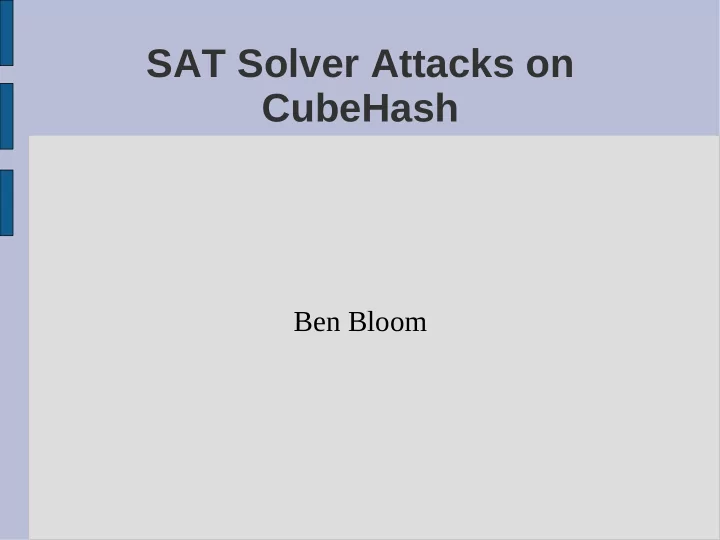

SAT Solver Attacks on CubeHash Ben Bloom
Hash Functions Variable length input, fixed length output. H(m) = h
Cryptographic Hash Functions Preimage resistance Collision resistance
Applications of Cryptographic Hash Functions Data Integrity Digital Signatures
Collision Application Create two messages M1 and M2 Have the Authority sign M1 Take the signature on M1 and put it with M2 Send M2 with the signature; others see M2 as authentic.
Satisfiability
Satisfiability NP-Complete problem Boolean expressions Conjunctive Normal Form
SAT Solvers Take a CNF expression, attempt to satisfy it. Complicated heuristics.
CubeHash
Overall Structure
Round Function Made of simple operations Addition and Exclusive Or Rotation and Swap
Round Function 0 1 2 3 4 5 6 7 8 9 10 11 12 13 14 15 16 17 18 19 20 21 22 23 24 25 26 27 28 29 30 31 8 9 10 11 12 13 14 15 0 1 2 3 4 5 6 7 32 33 34 35 36 37 38 39 40 41 42 43 44 45 46 47 48 49 50 51 52 53 54 55 56 57 58 59 60 61 62 63 34 35 32 33 38 39 36 37 42 43 40 41 46 47 44 45 52 53 54 55 48 49 50 51 60 61 62 63 56 57 58 59 64 65 66 67 68 69 70 71 72 73 74 75 76 77 78 79 80 81 82 83 84 85 86 87 88 89 90 91 92 93 94 95 65 64 67 66 69 68 71 70 73 72 75 74 77 76 79 78
The Attack
The Attack Collision Attack − Two random messages, same hash.
Attack Design Message 1 != Message 2 M1_B1 M1_B2 M1_B3 M2_B1 M2_B2 M2_B3 M1_B1 xor IV IV M2_B1 xor IV IV r rounds r rounds M1_S2 M1_S2 M2_S2 M2_S2 M1_B2 xor M1_S2 M1_S2 M2_B2 xor M2_S2 M2_S2 r rounds r rounds M1_S3 M1_S3 M2_S3 M2_S3 M1_B3 xor M1_S3 M1_S3 M2_B3 xor M2_S3 M2_S3 r rounds r rounds M1_S4 M1_S4 M2_S4 M2_S4 ==
Building the CNF
CNF for the Round Function Each operation is a Gate. Two inputs, one output. Addition has three inputs, two outputs. Each simple gate is four CNF clauses.
CNF for the Round Function XOR − (~A v ~B v ~C) (A v B v ~C) (A v ~B v C) (~A v B v C) AND − (~A v ~B v C) (~A v B v ~C) (A v ~B v ~C) (A v B v ~C) OR − (~A v ~B v C) (A v B v ~C) (A v ~B v C) (~A v B v C)
CNF for the Round Function Addition: A, B, Ci, Co, S, M, P, Q − M = A xor B A B Ci Co S − P = A and B 0 0 0 0 0 − Q = M and Ci 0 0 1 0 1 Carry-in of zero 0 1 0 0 1 0 1 1 1 0 − (xor(A,B, S)) (and(A,B,Co)) Ignore Carry-out 1 0 0 0 1 1 0 1 1 0 − (xor(A,B,M)) (xor(M,Ci, S)) 1 1 0 1 0 General Case 1 1 1 1 1 − (xor(A,B,M)) (xor(M,Ci, S)) (and(A,B, P)) (and(M,Ci,Q)) (or(P, Q,Co))
Variable Structure Round Function groups of 32. Rotations and Swaps taken care of here. Temporary Variables for Addition
CNF Variables ((224 + 192 * (r − 1)) * 32 + 8 * (128 − b)) * num_blocks * 2 + 8 * b * num_blocks + 8 * (128 − b) About 7500 per round block.
CNF Clauses (23808 * r * num_blocks) * 2 + 1 + 4 * (8 * b * num_blocks)+7 * 8 * (128 − b) + 8 * (128 − b) * (num_blocks − 1) * 5 About 25,000 per round block.
Byte Order Little and Big Endian at the same time. Keeping byte order straight
The Solution
SAT Solver Output Solver provides the variable assignments which satisfy the expression. Variables must be reconstructed in the proper order.
Colliding the SAT solver output SAT solver doesn't provide everything. Must perform final operation ourselves. Make the states equal at the end.
The Programs Three total programs. − RoundCNFProducer − glucose_static − CNFSolutionToHex Two java built by me, one C++ built for a SAT competition.
Results
CubeHash 1/b-512, 1 block
CubeHash 1/b-512
CubeHash r/1-512
Solve Time: CubeHash 1/b-512
Brute Force Expects to take 2 n/2 hash function evaluations Figure out how long one evaluation takes, multiply by expected number of evaluations.
Compare to Brute Force
Compare to Brute Force
Future Work Variable numbers of message blocks Improved SAT solver technology
Conclusions SAT solvers show strong potential for Cryptographic applications. The SAT attack looks to do better than a brute force attack.
Questions?
Recommend
More recommend